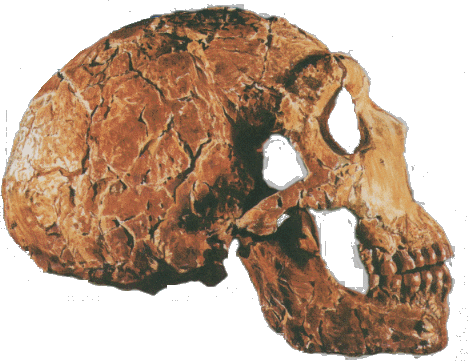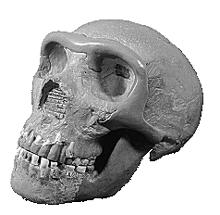 Neandertal
bones are thick and heavy; these mark them as people capable of enormous
exertion and endurance. Europe's Neandertals are believed to be the
first humans to move into truly cold climates.Their cranial capacity was
about 1500cc.
Neandertal
bones are thick and heavy; these mark them as people capable of enormous
exertion and endurance. Europe's Neandertals are believed to be the
first humans to move into truly cold climates.Their cranial capacity was
about 1500cc.
Neandertals
Neandertals are well-known archaic Homo sapiens.
Neandertal means 'Neander Valley', the site in Germany where they were
first found. Relative to modern Homo sapiens, Neandertals
had dense bones, thick skulls, and projecting brows. A popular misconception
of the Neandertal is the image of it as a stooped brute, of not very great
intelligence and a shambling gait. This is quite an untrue description.
Neandertals walked fully erect and actually had brains which were larger
than ours.  Neandertal
bones are thick and heavy; these mark them as people capable of enormous
exertion and endurance. Europe's Neandertals are believed to be the
first humans to move into truly cold climates.Their cranial capacity was
about 1500cc.
Neandertal
bones are thick and heavy; these mark them as people capable of enormous
exertion and endurance. Europe's Neandertals are believed to be the
first humans to move into truly cold climates.Their cranial capacity was
about 1500cc.
The Neandertal culture is called the
Mousterian culture. Their remains are found chiefly in caves and
rock shelters where they would have taken refuge from the harsh climate.
They had specialized stone tools and weapons. Large numbers of the
tools are thought to be scrapers used in dressing hides for clothing.  Neandertals
used a variety of stone tools and practiced ritualized burial of the dead.
In some of the more famous burials, stone tools and other objects were
associated with the bodies such that it suggests special concern for the
departed. Some Neandertal remains appear to have been decorated with
red ochre. Some paleoanthropologists believe that altruistic practices
and evidence of a social conscience are demonstrated by the Neandertals.
Neandertals have also been found in the Middle East. In the Middle
East the remains have been dated at 110000 years ago.
Neandertals
used a variety of stone tools and practiced ritualized burial of the dead.
In some of the more famous burials, stone tools and other objects were
associated with the bodies such that it suggests special concern for the
departed. Some Neandertal remains appear to have been decorated with
red ochre. Some paleoanthropologists believe that altruistic practices
and evidence of a social conscience are demonstrated by the Neandertals.
Neandertals have also been found in the Middle East. In the Middle
East the remains have been dated at 110000 years ago.
Modern Sapiens which are anatomically almost identical to modern humans appear first in Africa at 170 000 years ago. Neandertals and modern sapiens thus existed contemporaneously. The Neandertals were replaced quite abruptly by modern sapiens in Europe 40